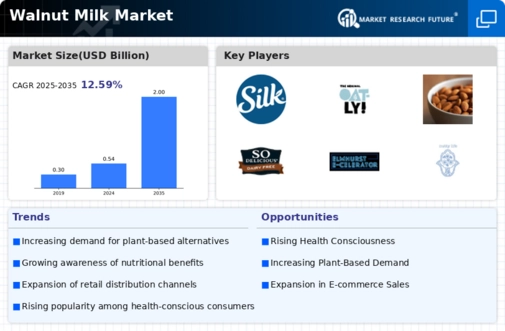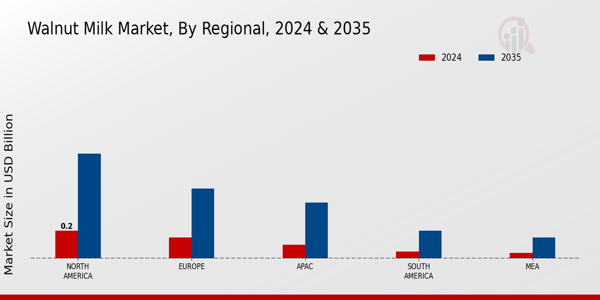Market Growth Projections
The Global Walnut Milk Market Industry is poised for substantial growth, with projections indicating a rise from 0.54 USD Billion in 2024 to 2 USD Billion by 2035. This trajectory suggests a robust compound annual growth rate (CAGR) of 12.64% from 2025 to 2035. Such growth is indicative of the increasing consumer acceptance of walnut milk as a viable alternative to traditional dairy products. Factors such as rising health consciousness, sustainability concerns, and innovative product offerings are likely to contribute to this upward trend. The market's expansion reflects a broader shift towards plant-based diets and healthier beverage choices.
Rising Health Consciousness
The Global Walnut Milk Market Industry is experiencing a surge in demand driven by increasing health consciousness among consumers. As individuals become more aware of the benefits of plant-based diets, walnut milk emerges as a nutritious alternative to dairy. Rich in omega-3 fatty acids, antioxidants, and vitamins, walnut milk appeals to health-focused consumers. The market is projected to reach 0.54 USD Billion in 2024, reflecting a growing preference for healthier beverage options. This trend is likely to continue, as consumers increasingly seek products that align with their wellness goals, thereby propelling the growth of the Global Walnut Milk Market Industry.
Innovative Product Offerings
Innovation within the Global Walnut Milk Market Industry is a key driver of growth. Manufacturers are introducing a variety of flavors and formulations to cater to diverse consumer preferences. For instance, the introduction of sweetened, unsweetened, and flavored walnut milk products allows consumers to choose options that suit their taste profiles. This diversification not only attracts a broader audience but also enhances market penetration. As companies invest in research and development to create unique offerings, the Global Walnut Milk Market Industry is poised for significant expansion, potentially achieving a CAGR of 12.64% from 2025 to 2035.
Sustainable and Ethical Consumption
Sustainability plays a pivotal role in shaping consumer preferences within the Global Walnut Milk Market Industry. As environmental concerns rise, consumers are gravitating towards plant-based alternatives that have a lower carbon footprint compared to traditional dairy. Walnut milk, being a sustainable choice, aligns with the values of eco-conscious consumers. This shift towards ethical consumption is expected to drive market growth, with projections indicating a rise to 2 USD Billion by 2035. The increasing awareness of sustainable practices among consumers suggests that walnut milk will continue to gain traction as a viable option in the beverage sector.
Growing Vegan and Plant-Based Diet Trends
The rise of veganism and plant-based diets significantly influences the Global Walnut Milk Market Industry. As more individuals adopt these lifestyles, the demand for dairy alternatives, including walnut milk, continues to grow. This trend is reinforced by the increasing number of vegan restaurants and food products available in the market. The shift towards plant-based diets is not merely a fad; it reflects a broader societal change towards healthier eating habits. As the market adapts to these evolving dietary preferences, walnut milk is likely to see sustained growth, contributing to the projected increase to 2 USD Billion by 2035.
Increased Availability in Retail Channels
The accessibility of walnut milk in various retail channels is a crucial factor driving the Global Walnut Milk Market Industry. Supermarkets, health food stores, and online platforms are increasingly stocking walnut milk products, making them readily available to consumers. This enhanced distribution network facilitates consumer trial and adoption, contributing to market growth. As more retailers recognize the demand for plant-based alternatives, the availability of walnut milk is expected to expand further. This trend not only supports the current market valuation of 0.54 USD Billion in 2024 but also positions the industry for future growth as consumer preferences evolve.
























Leave a Comment